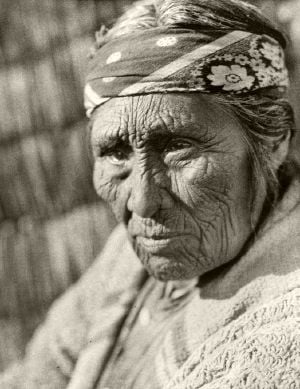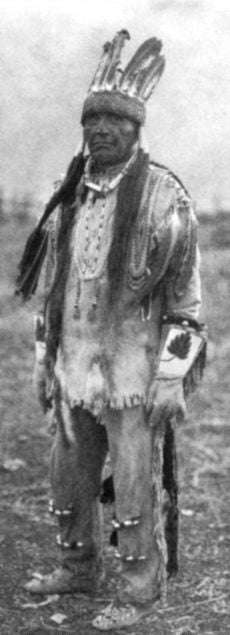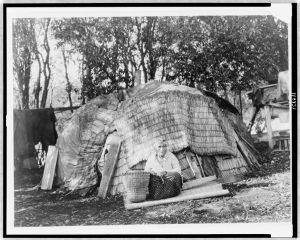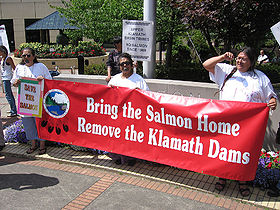Klamath

The Klamath are a Native American tribe of the Plateau culture area in Southern Oregon. Together with the Modoc, and Yahooskin they form the Klamath Tribes, a federally recognized confederation of three Native American tribes who traditionally inhabited Southern Oregon and Northern California in the United States. The tribal government is based in Chiloquin, Oregon.
Classification
The Klamath people are grouped with the Plateau Indians—the peoples who originally lived on the Columbia River Plateau. They were most closely linked with the Modoc people.
Both peoples called themselves maklaks, meaning people. When they wanted to distinguish between themselves, the Modoc were called Moatokni maklaks, from muat meaning "South." The Klamath people were called Eukshikni, meaning "lake people."
History
Prior to the arrival of European explorers, the Klamath people lived in the area around the Upper Klamath Lake and the Klamath, Williamson, and Sprague rivers. They subsisted primarily on fish and gathered roots and seeds.
The Klamath were known to raid neighboring tribes (such as the Achomawi on the Pit River), and occasionally to take prisoners as slaves. They traded with the Chinookan people.
In 1826, Peter Skene Ogden, an explorer for the Hudson's Bay Company, first encountered the Klamath people, and he was trading with them by 1829.
The United States, the Klamaths, Modocs, and Yahooskin band of Snake tribes signed a treaty in 1864, establishing the Klamath Reservation, to the northeast of Upper Klamath Lake. The treaty had the tribes cede the land in the Klamath Basin, bounded on the north by the 44th parallel, to the United States. In return, the United States was to make a lump sum payment of $35,000, and annual payments totaling $80,000 over 15 years, as well as providing infrastructure and staff for the reservation. The treaty provided that, if the Indians drank or stored intoxicating liquor on the reservation, the payments could be withheld and that the United States could locate additional tribes on the reservation in the future. The tribes requested Lindsay Applegate as the agent to represent the United States to them.
After signing the 1864 treaty, members of the Klamath Tribes moved to the Klamath Reservation. At the time there was tension between the Klamath and Modoc, and a band of Modoc left the reservation to return to Northern California. They were defeated by the US Army after the Modoc War (1872-1873), and were forced to return to Oregon. The Indian agent estimated the total population of the three tribes at about 2,000 when the treaty was signed.
In 1954, the US Congress terminated federal recognition of tribal sovereignty of the Klamath, as part of an effort to assimilate American Indians judged ready to be part of mainstream culture.
With the growth of Indian activism in the late twentieth century, the tribes reorganized their government and, in 1986, regained federal recognition. By this time, some members had sold their individual plots of land allocated in the 1950s, so the communal reservation land was broken up. A portion of that land was acquired by the government for the Klamath Basin National Wildlife Refuges Complex. Their tribal government is based in Chiloquin, Oregon.
Culture
Language
The language of the Klamath tribe is a member of the Plateau Penutian family. Klamath was previously considered a language isolate.
The Klamath-Modoc (or Lutuamian) language has two dialects:
- Klamath
- Modoc
After contact with Europeans, Klamath began learning English for contact with the larger world while retaining the Klamath tribal language for use at home. However, as English became the language of literacy, used in formal educaiton, the Klamath language was not passed on to younger tribal members. It was preserved by elders, and in writing systems, such as that created by M.A.R. Barker in 1963.[1]
Social structure
Lifestyle
According to Klamath oral history, the Klamath people have lived in the Klamath Basin from time immemorial. They believe that stability is key to success, and that their continued presence in this land is essential to the well-being of of their homeland.
Legends tell about when the world and the animals were created, when the animals the Creator, sat together and discussed the creation of man. "Work hard so that people will respect you" is the standard of Klamath culture. It is based on the belief that everything they needed to live was provided for by the Creator. In the spring the c'waam (Suckerfish) swim up the Williamson, Sprague, and Lost Rivers to spawn, and the Klamath have traditionally held a ceremony to give thanks for their return. This celebration includes traditional dancing, drumming, feasting, and releasing of a pair of c'waam into the river.[2]
Art
Music
Contemporary life
The Klamath Tribes, formerly the Klamath Indian Tribe of Oregon, are a federally recognized confederation of three Native American tribes who traditionally inhabited Southern Oregon and Northern California in the United States: the Klamath, Modoc, and Yahooskin. The tribal government is based in Chiloquin, Oregon.
The stated mission of the Tribes is as follows:
The mission of the Klamath Tribes is to protect, preserve, and enhance the spiritual, cultural, and physical values and resources of the Klamath, Modoc, and Yahooskin Peoples, by maintaining the customs and heritage of our ancestors. To establish a comprehensive unity by fostering the enhancement of spiritual and cultural values through a government whose function is to protect the human and cultural resources, treaty rights, and to provide for the development and delivery of social and economic opportunities for our People through effective leadership.[3]
There are currently around 3,500 enrolled members in the Klamath Tribes, with the population centered in Klamath County, Oregon.[3] Most tribal land was liquidated when Congress ended federal recognition in 1954 under its Indian termination policy. Some lands were restored when recognition was restored. The tribal administration currently offers services throughout the county.
The Klamath Tribes opened the Kla-Mo-Ya Casino (named after Klamath, Modoc, and Yahooskin) in Chiloquin, Oregon in 1997. It provides revenue which the tribe uses to support governance and investment for tribal benefit.
The Culture and Heritage Department of the Klamath Tribes develop projects designed to meet the social, spiritual and cultural needs of the Tribes,such as Tribal ceremonies and Culture Camps for Tribal youth. Annual events include the Restoration Celebration held the fourth weekend in August and the New Year’s Eve Sobriety Pow Wow.
The site protection program preserves ancestral and sacred sites and landscapes in cooperation with federal, state and local land management agencies, private developers and land owners. A Tribal Museum is planned.[4]
The Klamath Tribes Language Project is an effort to help keep alive and revitalize the Klamath Language. A basic course endorsed by the Culture and Heritage Department has been produced to introduce Klamath writing and pronunciation to tribal members.[5]
Klamath Indian Reservation
The present day Klamath Indian Reservation consists of twelve small non-contiguous parcels of land in Klamath County. These fragments are generally located in and near the communities of Chiloquin and Klamath Falls. Their total land area is 1.248 km² (308.43 acres). Few of the Klamath tribal members actually live on reservation land.
Water rights dispute
In 2001, an ongoing water rights dispute between the Klamath Tribes, Klamath Basin farmers, and fishermen along the Klamath River became national news. To improve fishing for salmon and the quality of the salmon runs, the Klamath Tribes pressed for dams to be demolished on the upper rivers. These dams have reduced the salmon runs and threatened the salmon with extinction.[6]
By signing the treaty of 1864,[7] the Klamath tribe ceded 20 million acres (81,000 km²) of land but retained 2 million acres (8,100 km²) and the rights to fish, hunt, trap, and gather from the lands and waters as they have traditionally done for centuries.[8]
When, as part of an effort at assimilation, the US Congress terminated the federal relationship with the Klamath Tribes in 1954, it was stated in the Klamath Termination Act, "Nothing in this [Act] shall abrogate any water rights of the tribe and its members... Nothing in this [Act] shall abrogate any fishing rights or privileges of the tribe or the members thereof enjoyed under Federal treaty."[8]
The states of California and Oregon have both tried to challenge Klamath water rights, but have been rebuffed. Local farmers tried unsuccessfully to claim water rights in the 2001 cases, Klamath Water Users Association v. Patterson and Kandra v. United States but these were decided in favor of the Department of Interior's right to give precedence to tribal fishing in its management of water flows and rights in the Klamath Basin.[8] In 2002 U.S. District Judge Owen M. Panner ruled that the Klamath Tribes' right to water preceded that of non-tribal irrigators in the court case United States vs. Adair, originally filed in 1975.[9]
In 2010, the final draft of the Klamath Basin Restoration Agreement (KBRA), "A Blueprint for Progress and Sustainability in the Klamath Basin," was released as a proposal to resolve the complex issues of the Klamath Basin.[10] The Klamath Tribes voted to support the KBRA.[11] In February, 2010, representatives of the Klamath, Yurok, and Karuk tribes, together with political leaders from federal, state and local governments gathered to sign the Klamath Restoration Agreements at the state capital in Salem, Oregon. Dam removal is scheduled to begin in 2020, pending federal legislation to authorize the plan.[12]
Notes
- ↑ M.A.R. Barker, Klamath Dictionary (University of California Press, 1963).
- ↑ History klamathtribes.org. Retrieved April 9, 2013.
- ↑ 3.0 3.1 Klamath Tribal Culture. klamathtribes.org. Retrieved April 9, 2013.
- ↑ Culture and Heritage Department. klamathtribes.org. Retrieved April 9, 2013.
- ↑ Klamath Tribes Language Project. klamathtribes.org. Retrieved April 9, 2013.
- ↑ Top Ten Reasons to Remove Klamath Dams Klamath Restoration Agreements. Retrieved April 12, 2013.
- ↑ Treaty with the Klamath, etc. Oklahoma State University. Retrieved April 9, 2013.
- ↑ 8.0 8.1 8.2 "Klamath Tribes' Water Rights." The Klamath Tribes. Retrieved April 12, 2013.
- ↑ "Judge affirms Klamath Tribes' water right of time immemorial", U.S. Water News Online, March 2002. Retrieved April 12, 2013.
- ↑ Klamath Basin Restoration Agreement Klamath Restoration Agreements. Retrieved April 12, 2013.
- ↑ Klamath Tribes Historic Vote Passes Overwhelmingly Klamath Tribes Press Release, January 19, 2010. Retrieved April 12, 2013.
- ↑ Historic Klamath Restoration Agreements Signed Klamath Restoration Agreements. Retrieved April 12, 2013.
ReferencesISBN links support NWE through referral fees
- Barker, M.A.R. Klamath Dictionary. University of California Press, 1963. ASIN B008YWCMCK
- Gatschet, Albert Samuel. The Klamath Indians of Southwestern Oregon. Forgotten Books, 2012. ASIN B008G2FKVS
- Hale, H. "The Klamath Nation: the country and the people." Science, 19(465) (1892).
- Mithun, Marianne. The Languages of Native North America. Cambridge: Cambridge University Press, 2001. ISBN 978-0521298759
- Pritzker, Barry M. A Native American Encyclopedia: History, Culture, and Peoples. New York, NY: Oxford University Press, 2000. ISBN 978-0195138771
- Waldman, Carl. Encyclopedia of Native American Tribes. New York, NY: Checkmark Books, 2006. ISBN 978-0816062744.
- Wolf, Edward C. Klamath Heartlands: A Guide to the Klamath Reservation Forest Plan. Oregon State University Press, 2004. ISBN 978-0967636436
External links
All links retrieved
- Guide to the Klamath Tribal Council papers (1933-1958) at the University of Oregon
- The Klamath Tribes Website
- The Klamath Tribes
- Klamath Basin Restoration Agreement
- Klamath Tribes Oregon Blue Book
Credits
New World Encyclopedia writers and editors rewrote and completed the Wikipedia article in accordance with New World Encyclopedia standards. This article abides by terms of the Creative Commons CC-by-sa 3.0 License (CC-by-sa), which may be used and disseminated with proper attribution. Credit is due under the terms of this license that can reference both the New World Encyclopedia contributors and the selfless volunteer contributors of the Wikimedia Foundation. To cite this article click here for a list of acceptable citing formats.The history of earlier contributions by wikipedians is accessible to researchers here:
The history of this article since it was imported to New World Encyclopedia:
Note: Some restrictions may apply to use of individual images which are separately licensed.




